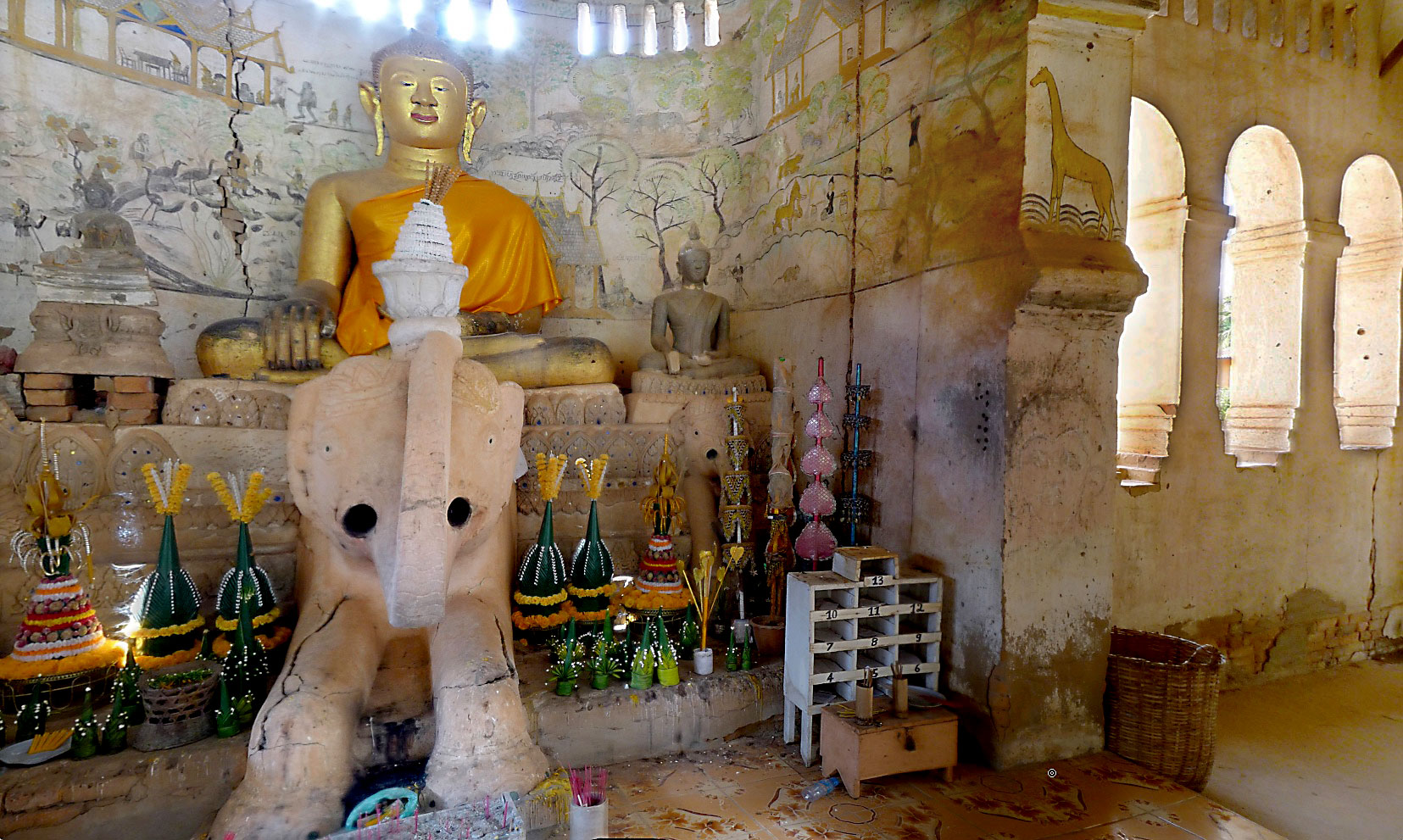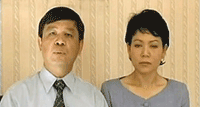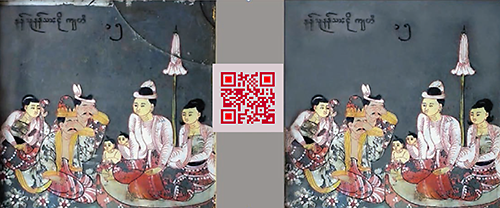
Digital and Analog Replications in the Restoration Museology of Theravada Temple Art: case studies from Laos and Thailand
Presentation prepared for the Pacific Neighborhood Consortium Conference, U. of Arizona, Tucson AZ, USA: 16-18 September 2022
Following the 1975 collapse of the erstwhile Kingdom of Laos, the new revolutionary regime closed down the monasteries and evicted the monks: an unpopular decision that was soon reversed, but conditional on the reestablished sangha staying out of politics and removing “superstition” from Lao Buddhist practice. That epithet came to include, not only relict animist and Tantric elements but also most aspects of Brahmanic culture, including the Phralak-Phralam (PLPL), which was the Lao adaptation of the great Indian Ramayana epic. Following our digitally intermediated replication in 2012 of the demolished Vat Oub Mong PLPL murals, It remains uncertain whether a decade later, the storylines and symbology of the “replicant” PLPL paintings came to be understood and re-embraced in local Buddhist practice.
Wat Jong Klan (WJK), in Mae Hong Son, Thailand was decorated with several hundred individual reverse glass paintings (RGPs), created in the late 1850s. This being a highly seismic region, and RGPs being a very easily damaged art medium, many of the paintings were severely fractured or otherwise degraded by a series of earthquakes over the following century. In 2008, we digitally photographed all the RGPs still extant at WJK. Using the Adobe Photoshop app, we developed a simple technology for “virtually repairing” the worst damaged originals; thence having their replacements digitally inkjet-printed on new glass panes and remounted in situ.
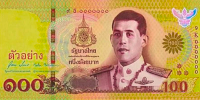
Restoring, Re-creating, and Elaborating Interpretive Materials for the Sri Thanonchai Interior Wall Paintings in Bangkok
“The White Lotus Press illustrations of the Wat Pathumwanaram lower course walls excluded the caption boxes below each of the main panels. Evidently, while undergoing extensive restorations (in 2010-2012, during which the wihaan was closed to the public, the original caption box texts were overpainted and the former several lines of the script weren’t included in any of the restorations as they presently stand.”
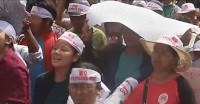
More equitable energy intensification in accordance with the Strategic Assessment (SEA) of Myanmar’s Hydropower Sector?
The recently-completed SEA of hydropower scenarios would rule out the two largest —and now “suspended”— such schemes: Myitsone (6,000 MW) on the Ayeyarwadi, for which the Chinese developers have already spent $100 million USD; and Mongton/Tasang (7,500 MW) on the Salween/Thanlwin: projects long and furiously opposed by restive, economically-marginalized, and self-militarizing ethnic minorities whose lands, cultures and autonomy are seen as disbenefitted. Prospects for reaching an agreement have been radically unhinged by the 1st February 2021 Tatmadaw coup; which was fastidiously bloodless at first but has since devolved into full-scale civil war.

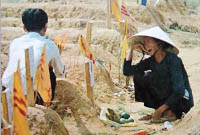
Excavating Orwellian Deconstructed
“All but the ghosts have abandoned the wartime cemetery here. No relatives visit. The monument to honor the sacrifice of the dead stands unfinished. The pagoda for family prayer is empty. Weeds run wild among the graves, and headstones lie toppled. A generation ago, when these boy soldiers died, bereaved mothers encased their photographs in stone markers. Surprisingly, many of the pictures have not faded. The faces —clear-eyed, clean-shaven, proud— much like those of the young men one sees today on the streets of Hanoi” Bien Hoa, Viet Nam: David Lamb, Los Angeles Times, 17 July 1998


In George Orwell’s seminal dystopian novel “1984”
“The Memory Hole” was both an appliance —a wall receptacle into which documents inconsistent with ruling party ideology would be reflexively deposited and whooshed pneumatically to a furnace somewhere below— and the permanent outcome of such usage: here unpacking attempted and accomplished memory holing in post-1975 Viet Nam, Thailand, and the United States.


Taleo Kao
An Interactive Visualization Archive of Vat Taleo Kao: a semi-abandoned, “destroyed” Buddhist temple, in Savannakhet Province, Lao PDR.
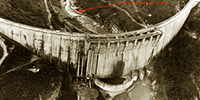
Waterfalls Hydropower Development
Visualization in Waterfalls Hydropower Aesthetics: Impact Assessment, Mitigation, and Post-facto Evaluation.

Transformation and Reclamation of Vientiane’s Mekong Waterfront
An interactive archive of the urbanization of the Lao P.D.R.’s capital: 1898 (population ~5,000) through 2012 (population ~650,000).

Pak Mun/Mekong Orwell
Arguably —in weighing the trivial power produced against the phenomenal downside— the worst hydroelectric dam ever built, anywhere.

Mekong Memory Hole
This was originally produced by the Resources Renewal Institute (RRI), as a part of their video series “Environmental Elders”. It is still available on the RRI website, and I would encourage you to look through the rest of the Environmental Elders productions, Go directly to this URL… vimeo.com/86935784
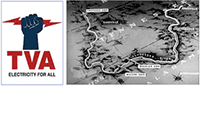
TVA on the Mekong: the semi-abandoned American visionary roots of Mekong Basin hydropower development.
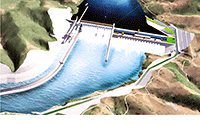
Facing communist insurgencies following French Indochina’s collapse, the United States conceived a Mekong basin-wide approach to social and economic uplift on the TVA model. The Development and Resources Corporation —”D&R”; headed by former TVA Director David E. Lilienthal, and which operated from 1955 to 1979— devised the Pak Beng scheme: its keystone project, which lay dormant for three decades.

Boeung Kak
“Reclaiming” Boeung Kak for high-end development took evicting 2,000 former shoreline households and 4,000,000 cubic meters of pumped landfill.
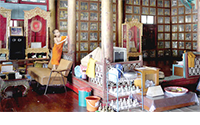
Wat Jong Klong
The 2004 earthquake damaged or destroyed many of the original reverse glass paintings, of which there was then no hi-rez archive.

Burmese Reverse Glass Paintings at Wat Chong Klan, Lan Na (Thailand).
Phrakeo Morakot
The Phrakeo Morakot and the assassinations in Nong Khai of the pretenders to the Lao Lanexang throne: A hypothetical linkage.
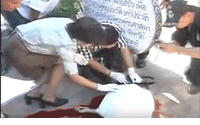
Murdered Lao Lanexane Pretenders Media Coverage
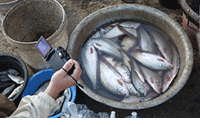
Digital Mekong Planning/NT2
Before Nam Theun 2, outsiders were welcomed to harvest small catfishes (Mystus spp.) migrating up the Nam Pheet to enter the flooded forest.

Atlas of Mekong Fishes
Some sixty million people inhabiting the Mekong basin have as their primary protein source fishes harvested from its waterways.

Mekong Actual Outcomes
Poster-manifesto for the regrettably canceled Mekong Actual Outcomes Conference: a career-killer for international development insiders candidly critiquing failed projects?

Khone Phapeng Aesthetics
Before the Don Sahong hydroelectric project in Siphandone (Lao PDR), Khone Falls, “the Niagara of Asia” —unlike Niagara itself— had never been industrialized.
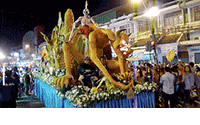
Ubon Wax
For Asala Puja, many Ubon temples provide workshops for devotées to construct elaborate mobile juggernauts in Buddhist and Brahmanic styles.

Escaping Foreign Donor Nature Worship
IUCN’s 1995 survey of Nong Chanh marsh in Vientiane showed its annual productivity —fish, wildlife, plants, and “ecological services”— worth USD $1 million.
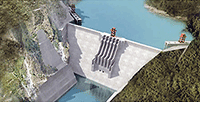
Mong Ton/Tasang hydropower: (7,000 MW!) Following an armed uprising in Myanmar’s Shan State, the Project has not yet been implemented: even performing the EIA is now impossible.
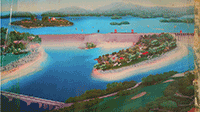
Myitsone
Facilitating Sino-Myanmar hydroelectric development cooperation.
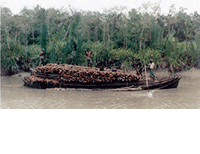
Watering the Bangladeshi Sundarbans, redux
Blaming up-basin freshwater diversions, in 2016, UNESCO presented an extremely critical report on the worsening mismanagement of the world’s largest estuarine mangrove forest.

Interbasin transfers within Thailand
There presently exist neither basinwide agreements nor bilateral treaties regarding project impacts —including water diversions— between the Salween/Thanlwin’s co-riparians: China, Burma/Myanmar, and Thailand.

Visualizing Giants Tank through eighteenth-century Dutch sources
Originally impounded twenty centuries ago —although mostly in ruins since the early modern era— its rehabilitation would irrigate ~25,000 hectares of under-producing rainfed paddy.
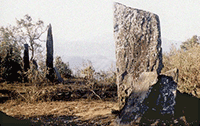
Keohintang Menhirs, Houaphanh Province Laos
At least 1,500 years ago, people of whose origins and fate we know almost nothing, erected hundreds of standing stone monuments atop wilderness ridgelines.

Lao Buddhas in Four Thai Wats
Following wars between the Kingdoms of Siam and Lao Lanxang during the 18th-19th centuries CE, particularly-venerated Buddha images are in temples now in Bangkok and Isaan.
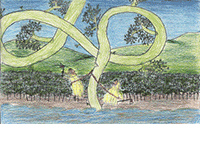
World Heritage Class 1998, Bilingue
Ten and eleven-year-olds from Ecole Hoffet and the Vientiane International School spent one week together documenting their experiences of Luang Prabang’s geography, architecture, history, and mythology.
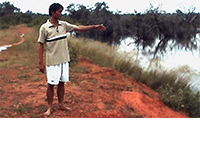
Before the Internet was really practicable there, the World Bank loaned $25M to the Lao PDR to rehabilitate 23 lapsed irrigation schemes; bringing forth unorthodox “Safeguard” technologies for overcoming problems, visualizing sites, and documenting success or failure.

Human rights components of an eBook portfolio: a contribution to the Pacific Neighborhood Consortium’s 2018 conference, themed “human rights in cyberspace”; presenting here contrarian perspectives on the globalized conventional wisdom and its enemies.

Shan Resistance to Salween Hydropower Thanlwin/Salween dams driving a Shan armed uprising long predating the energy-starved Union of Myanmar’s forced embrace.
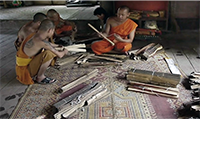
Lao Ramayana murals replicant eBook assemblage for IGNCA, Delhi
Reversing visual and textual memory loss and cultural collateral damage; identifying and digitizing 1,250 double-sided palm leaf bailane (comprising 97% of the original manuscript pages).
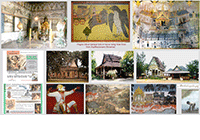
DigitalHERITAGE 2018 Expo: Fort Mason, San Francisco
Phralak-Phralam: online video walkthrough (35 minutes)

Are fisheries impacts of riparian deforestation in Siphandone already eclipsing hydropower effects?
Catfishes in the family Pangasidae —of which Mekong wild populations are evidently in sharp decline— lay their adhesive eggs within the tangled external root mass of certain “flooded forest” trees. Presented at Environmental Change, Agricultural Sustainability, and Economic Development in the Lower Mekong Basin, Royal University of Phnom Penh, March 2017.

Baima Dam (fictitious) on the Nujiang: S/EIA simulation.
Summer abroad course for American undergrads at Yunnan University on Mekong/Salween water resources development. Prof exposed by the Woke and Triggered as a Fake Expert and Sexual Predator; but in retrospect, All Good (almost).

Three Stories from Eye Corps
Thinly-fictionalized illustrated reportage: originally written in 1969-70 and presented at Cantigny Park (Chicago) at the symposium “Teaching the Viet Nam War”, 4 May 2019.

An early overview of Nam Ngum Basin development planning
With grandiose projects on the horizon to convert the undammed upper reaches into stair-cased hydropower reservoirs, bio-diversity was then still a major asset and its protection and conservation warranting prioritization: was subsequently mostly ignored.

The Kaptai hydropower project was built during the 1960s in former East Pakistan’s Chittagong Hill Tracts
Tens of thousands of involuntarily-relocated Chakma Buddhist minority people —mostly wet-rice farmers— received nearly zero compensation, leading to guerilla violence and thence mass resettlement of lowland Bengali Muslims. Many displaced Chakma had for decades eked out a living in the reservoir draw-down ring: likely soon foreclosed by a turbine efficiency upgrade.
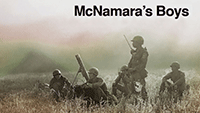
Crossroads Viet Nam Experience: “McNamara’s Morons”?
Unscripted screen capture walk-through of a new eBook, still offline, narrowly focused on the 17th December 1968 refueling of a C-123 aircraft, which crashed on take-off from Chu Lai killing all but nine of the 45 crew and passengers aboard. Angrily — and perhaps mistakenly — laying blame on recruiting 300,000 “mentally deficient” draftees who were previously denied enlistment.

Illustrating Arakan
In 1992-93, Catherine Raymond; architect/draughtsman Jean Othoffer; and Noah and Alan Potkin surveyed Bangladesh’s “relict” Rakhine communities and sites lying between Maheshkali Island and Teknaf, but focused on the area around Ramu: traditionally the center of Rakhine culture in southeastern Bengal.
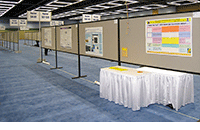
Electrifying dismal conference posters
Using nearly any hand-held gizmo, a disengaged conference attendee speed-walking through a “poster session” hallway, but intrigued by an atypical display print chockablock with QR glyphs, could access interactively —item-by-item—the complete eBook from which it was extracted.
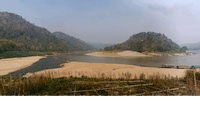
Impasse on the Lower Salween: is it resolvable?
Myanmar’s minority communities appear disproportionally impacted by energy development and water resources management schemes. The Salween Peace Park was “declared” in 2018 by local activists favoring Karen/Kayin autonomy and awarded UNDP’s 2020 Equator Prize; notwithstanding the 5,400 km2 SPP site being largely occupied at present by military forces constitutionally opposed to armed anti-National ethnic factions.

Impasse on the Lower Salween in light of the Myanmar coup
A speculative “grand bargain” accepting the Thai Royal Irrigation Department’s inter-basin transfer (IBT) scheme diverting Thanlwin/Salween waters into the Chaophraya, thus stabilizing the hydrological derangement of metro Bangkok; constructing the Hat Gyi hydropower project to deliver the vast energy required to power that IBT; and with its complete demilitarization, essentially implementing the Salween Peace Park? Far-fetched from the outset, and even more unimaginable now than before? Or a plausible reconciliation strategy with the Tatmadaw?

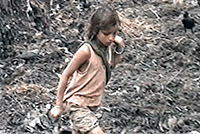
Familiarizing mid-level Bangladeshi government staff with the basics of ecological and social impact assessment (1992-93)
The training video, professionally produced in a long-since obsolete analog format under an ADB contract with DanEduc As (Denmark), demonstrating also the creation and utility of S/EIA media. The case study was the World Bank’s “Environmental Improvement Project, Dhaka”, which —amazingly— was conceptualized and then already well under implementation: absent even preliminary impact evaluation. Appreciably damaged from random noise, visual artifacts, and data loss across multiple dubbings; but marginally well-restored in this new digital version.
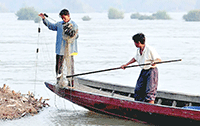
Fisheries Ecology Evaluation of the Don Sahong hydropower scheme: Siphandone (Champassak), Laos: This eBook’s original compilation in 2013-15 presented both the developer’s approaches to monitoring fisheries within and nearby the Don Sahong dam site and the concerns of stakeholders over what they would have been one of the first Mekong mainstem hydroelectric projects within the MRC countries. A key issue was the prospective blockage of a critical dry-season fish migration pathway and compensatory alternate channel improvements.
 —trained originally as a limnologist specializing in tropical rivers— holds a doctorate in environmental planning (Ph. D., 1989) from U.C. Berkeley. His focus has always been on media applications in cultural and ecological conservation, and on the evolving interactive visualization toolbox for strengthening impact assessment, public participation, and post-facto evaluation. A combat veteran of the Second Indochina War —wherefrom emerged a not-so-hidden agenda towards personally undoing some part of the damage— he was based in Vientiane from 1995 through 2002. While there he founded the Digital Conservation Facility, Laos (DCFL): affiliated since 2003 with both the Center for Southeast Asian Studies at Northern Illinois U. (NIU) and the NIU Center for Burma Studies. Dr. Potkin’s recent research has been on the aesthetics of waterfalls hydro power in Sri Lanka; on the 12,000 MW Myitsone cascade project on the Ayeyarwady headwaters in Myanmar’s troubled Kachin State; on museums as essential to pharaonic projects; and on downstream learning —broadly defined— from Mekong Basin actual outcomes.
—trained originally as a limnologist specializing in tropical rivers— holds a doctorate in environmental planning (Ph. D., 1989) from U.C. Berkeley. His focus has always been on media applications in cultural and ecological conservation, and on the evolving interactive visualization toolbox for strengthening impact assessment, public participation, and post-facto evaluation. A combat veteran of the Second Indochina War —wherefrom emerged a not-so-hidden agenda towards personally undoing some part of the damage— he was based in Vientiane from 1995 through 2002. While there he founded the Digital Conservation Facility, Laos (DCFL): affiliated since 2003 with both the Center for Southeast Asian Studies at Northern Illinois U. (NIU) and the NIU Center for Burma Studies. Dr. Potkin’s recent research has been on the aesthetics of waterfalls hydro power in Sri Lanka; on the 12,000 MW Myitsone cascade project on the Ayeyarwady headwaters in Myanmar’s troubled Kachin State; on museums as essential to pharaonic projects; and on downstream learning —broadly defined— from Mekong Basin actual outcomes.
